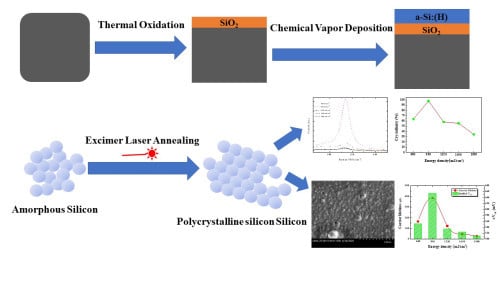Crystallization of Amorphous Silicon via Excimer Laser Annealing and Evaluation of Its Passivation Properties
Abstract
:1. Introduction
2. Materials and Methods
3. Results and Discussions
3.1. Crystallization of a-Si:H Using Heat Treatment
3.2. Crystallization of a-Si Using Excimer Laser Annealing
4. Conclusions
Author Contributions
Funding
Acknowledgments
Conflicts of Interest
References
- Dassow, R.; Köhler, J.R.; Grauvogl, M.; Bergmann, R.B.; Werner, J. Laser-Crystallized Polycrystalline Silicon on Glass for Photovoltaic Applications. Solid State Phenom. 1999, 67, 193–198. [Google Scholar] [CrossRef]
- Staebler, D.L.; Wronski, C.R. Reversible conductivity changes in discharge-produced amorphous Si. Appl. Phys. Lett. 1977, 31, 292–294. [Google Scholar] [CrossRef]
- Mei, P.; Boyce, J.B.; Hack, M.; Lujan, R.; Ready, S.E.; Fork, D.K.; Johnson, R.I.; Anderson, G.B. Grain growth in laser dehydrogenated and crystallized polycrystalline silicon for thin film transistors. J. Appl. Phys. 1994, 76, 3194–3199. [Google Scholar] [CrossRef]
- Im, J.S.; Kim, H.J.; Thompson, M.O. Phase transformation mechanisms involved in excimer laser crystallization of amorphous silicon films. Appl. Phys. Lett. 1993, 63, 1969–1971. [Google Scholar] [CrossRef]
- Miyasaka, M.; Stoemenos, J. Excimer laser annealing of amorphous and solid-phase-crystallized silicon films. J. Appl. Phys. 1999, 86, 5556–5565. [Google Scholar] [CrossRef]
- Smith, P.M.; Carey, P.G.; Sigmon, T.W. Excimer laser crystallization and doping of silicon films on plastic substrates. Appl. Phys. Lett. 1997, 70, 342–344. [Google Scholar] [CrossRef]
- Song, D.; Inns, D.; Straub, A.; Terry, M.L.; Campbell, P.; Aberle, A.G. Solid phase crystallized polycrystalline thin-films on glass from evaporated silicon for photovoltaic applications. Thin Solid Film. 2006, 513, 356–363. [Google Scholar] [CrossRef]
- Brotherton, S.D.; McCulloch, D.J.; Clegg, J.B.; Gowers, J.P. Excimer-laser-annealed poly-Si thin-film transistors. IEEE Trans. Electron Devices 1993, 40, 407–413. [Google Scholar] [CrossRef]
- Komotori, J.; Lee, B.J.; Dong, H.; Dearnley, P.A. Corrosion response of surface engineered titanium alloys damaged by prior abrasion. Wear 2001, 251, 1239–1249. [Google Scholar] [CrossRef]
- Sato, H.; Nishio, S. Polymer laser photochemistry, ablation, reconstruction, and polymerization. J. Photochem. Photobiol. C Photochem. Rev. 2001, 2, 139–152. [Google Scholar] [CrossRef]
- Love, R.A.; Parge, H.E.; Wickersham, J.A.; Hostomsky, Z.; Habuka, N.; Moomaw, E.W.; Adachi, T.; Hostomska, Z.J.C. The crystal structure of hepatitis C virus NS3 proteinase reveals a trypsin-like fold and a structural zinc binding site. Cell 1996, 87, 331–342. [Google Scholar] [CrossRef] [Green Version]
- Mohan, S. Fiber Optics and Laser Instrumentation: (for EEE, EI, Electronics, Computer Science & Engineering, Physics and Materials Science Students in Indian Universities); MJP Publisher: Tamil Nadu, India, 2019. [Google Scholar]
- Carluccio, R.; Cina, S.; Fortunato, G.; Friligkos, S.; Stoemenos, J. Structure of poly-Si films obtained by laser annealing. Thin Solid Film. 1997, 296, 57–60. [Google Scholar] [CrossRef]
- Kuriyama, H.; Nohda, T.; Ishida, S.; Kuwahara, T.; Noguchi, S.; Kiyama, S.; Tsuda, S.; Nakano, S. Lateral Grain Growth of Poly-Si Films with a Specific Orientation by an Excimer Laser Annealing Method. Jpn. J. Appl. Phys. 1993, 32, 6190–6195. [Google Scholar] [CrossRef]
- McCulloch, D.J.; Brotherton, S.D. Surface roughness effects in laser crystallized polycrystalline silicon. Appl. Phys. Lett. 1995, 66, 2060–2062. [Google Scholar] [CrossRef] [Green Version]
- Boyce, J.B.; Mei, P. Laser Crystallization for Polycrystalline Silicon Device Applications. In Technology and Applications of Amorphous Silicon; Street, R.A., Ed.; Springer: Berlin/Heidelberg, Germany, 2000; pp. 94–146. [Google Scholar]
- Bidin, N.; Ab Razak, S.N. ArF Excimer Laser Annealing of Polycrystalline Silicon Thin Film. In Crystallization: Science and Technology; Intech Open Publisher: London, UK, 2012; p. 481. [Google Scholar]
- Kühnapfel, S.; Severin, S.; Kersten, N.; Harten, P.; Stegemann, B.; Gall, S. Multi crystalline silicon thin films grown directly on low cost soda-lime glass substrates. Sol. Energy Mater. Sol. Cells 2019, 203, 110168. [Google Scholar] [CrossRef]
- Mallem, K.; Kim, Y.J.; Hussain, S.Q.; Dutta, S.; Le, A.H.T.; Ju, M.; Park, J.; Cho, Y.H.; Kim, Y.; Cho, E.-C.; et al. Molybdenum oxide: A superior hole extraction layer for replacing p-type hydrogenated amorphous silicon with high efficiency heterojunction Si solar cells. Mater. Res. Bull. 2019, 110, 90–96. [Google Scholar] [CrossRef]
- Kimmerle, A.; Rothhardt, P.; Wolf, A.; Sinton, R.A. Increased Reliability for J0-analysis by QSSPC. Energy Procedia 2014, 55, 101–106. [Google Scholar] [CrossRef]
- Koo, K.; Kim, S.; Choi, P.; Kim, J.; Jang, K.; Choi, B. Electrical evaluation of the crystallization characteristics of excimer laser annealed polycrystalline silicon active layer. Jpn. J. Appl. Phys. 2018, 57, 106503. [Google Scholar] [CrossRef]
- Mall, A.K.; Paul, B.; Garg, A.; Gupta, R. Temperature dependent X-ray diffraction and Raman spectroscopy studies of polycrystalline YCrO3 ceramics across the TC ~460 K. J. Raman Spectrosc. 2020, 51, 537–545. [Google Scholar] [CrossRef]
- Pangal, K.; Sturm, J.C.; Wagner, S.; Büyüklimanli, T.H. Hydrogen plasma enhanced crystallization of hydrogenated amorphous silicon films. J. Appl. Phys. 1999, 85, 1900–1906. [Google Scholar] [CrossRef]
- Meador, J.A. A Radiological Survey of Two Bruker D8 Advance XRD Instruments Located in Separate Quality Control Laboratories; West Virginia University Research Repository: Morgantown, WV, USA, 2016. [Google Scholar]
- Saleh, R.; Nickel, N.H. Raman spectroscopy of doped and compensated laser crystallized polycrystalline silicon thin films. Surf. Coat. Technol. 2005, 198, 143–147. [Google Scholar] [CrossRef]
- Yoo, W.S.; Ishigaki, T.; Ueda, T.; Kang, K.; Kwak, N.Y.; Sheen, D.S.; Kim, S.S.; Ko, M.S.; Shin, W.S.; Lee, B.S.; et al. Grain size monitoring of 3D flash memory channel poly-Si using multiwavelength Raman spectroscopy. In Proceedings of 2014 14th Annual Non-Volatile Memory Technology Symposium (NVMTS), Jeju Island, Korea, 27–29 October 2014; pp. 1–4. [Google Scholar]
- Morisset, A.; Cabal, R.; Grange, B.; Marchat, C.; Alvarez, J.; Gueunier-Farret, M.-E.; Dubois, S.; Kleider, J.-P. Highly passivating and blister-free hole selective poly-silicon based contact for large area crystalline silicon solar cells. Sol. Energy Mater. Sol. Cells 2019, 200, 109912. [Google Scholar] [CrossRef] [Green Version]
- Spruiell, J. A Review of the Measurement and Development of Crystallinity and Its Relation to Properties in Neat Poly (Phenylene Sulfide) and Its Fiber Reinforced Composites; Oak Ridge National Lab. (ORNL): Oak Ridge, TN, USA, 2005. [Google Scholar]
- Monshi, A.; Foroughi, M.R.; Monshi, M.R. Modified Scherrer equation to estimate more accurately nano-crystallite size using XRD. World J. Nano Sci. Eng. 2012, 2, 154–160. [Google Scholar] [CrossRef] [Green Version]
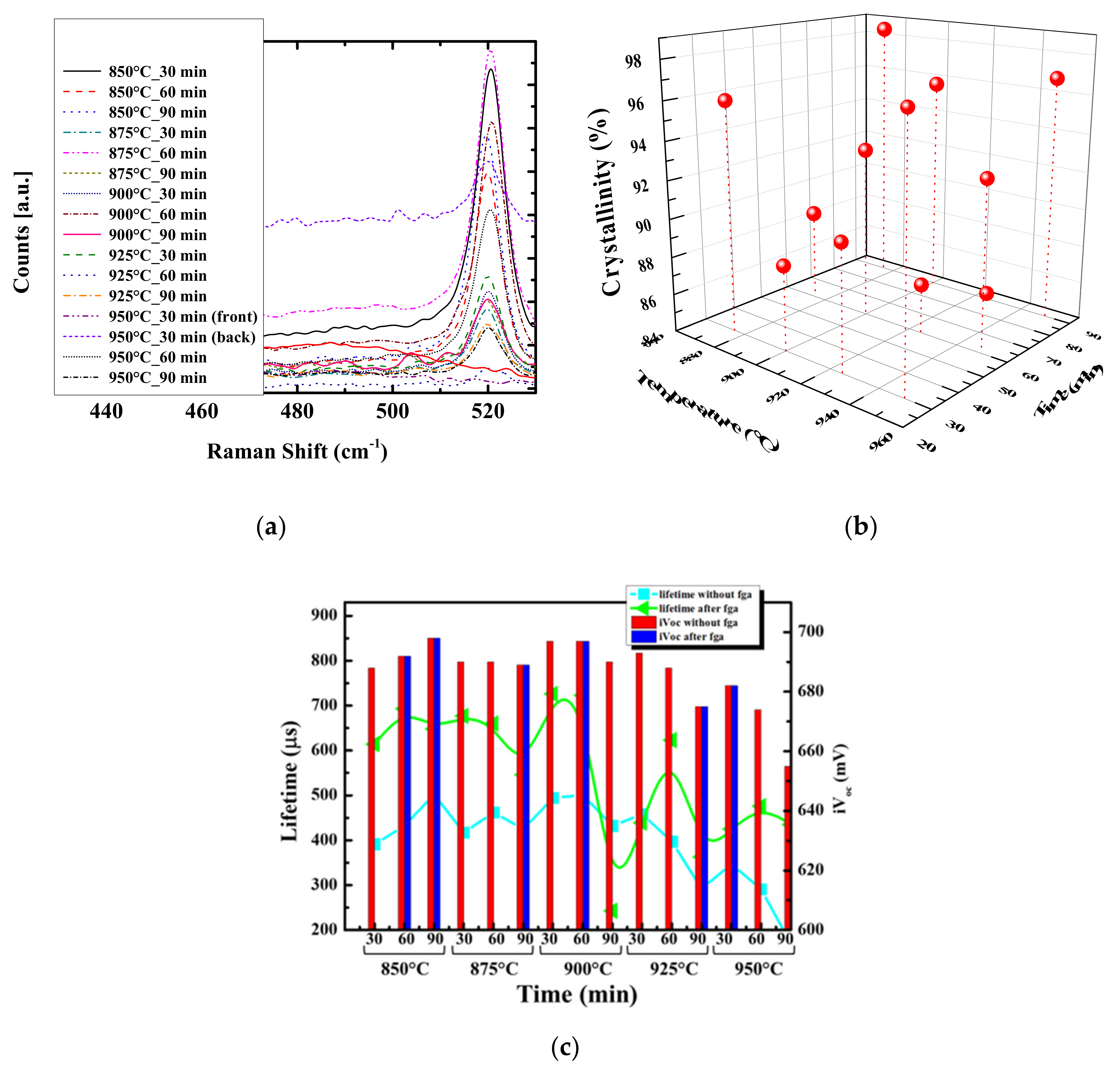
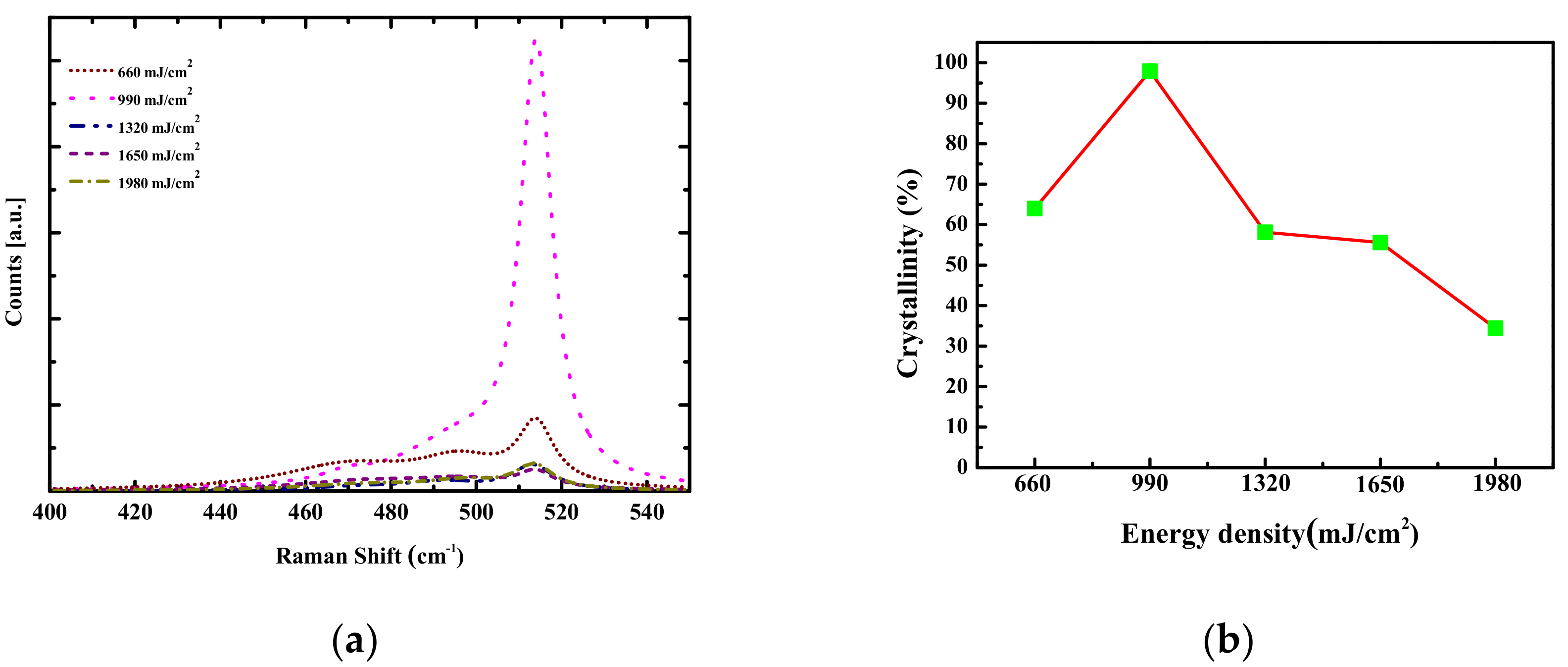
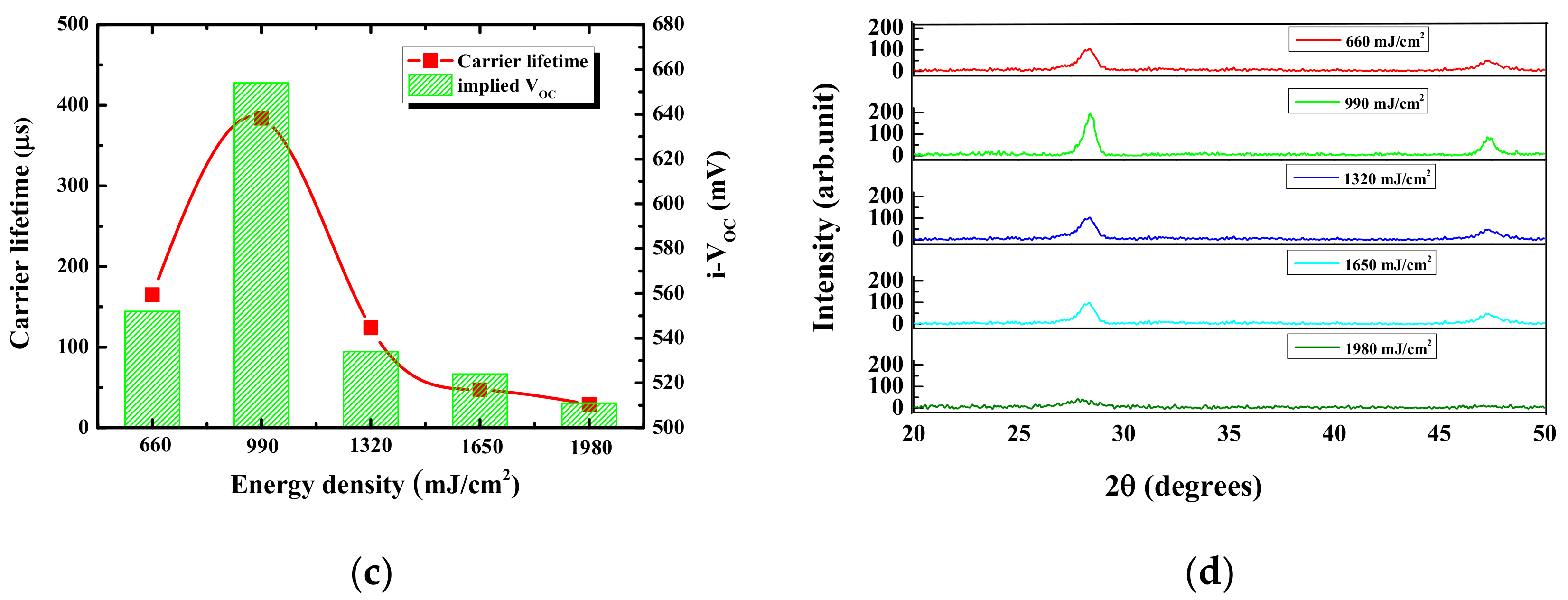

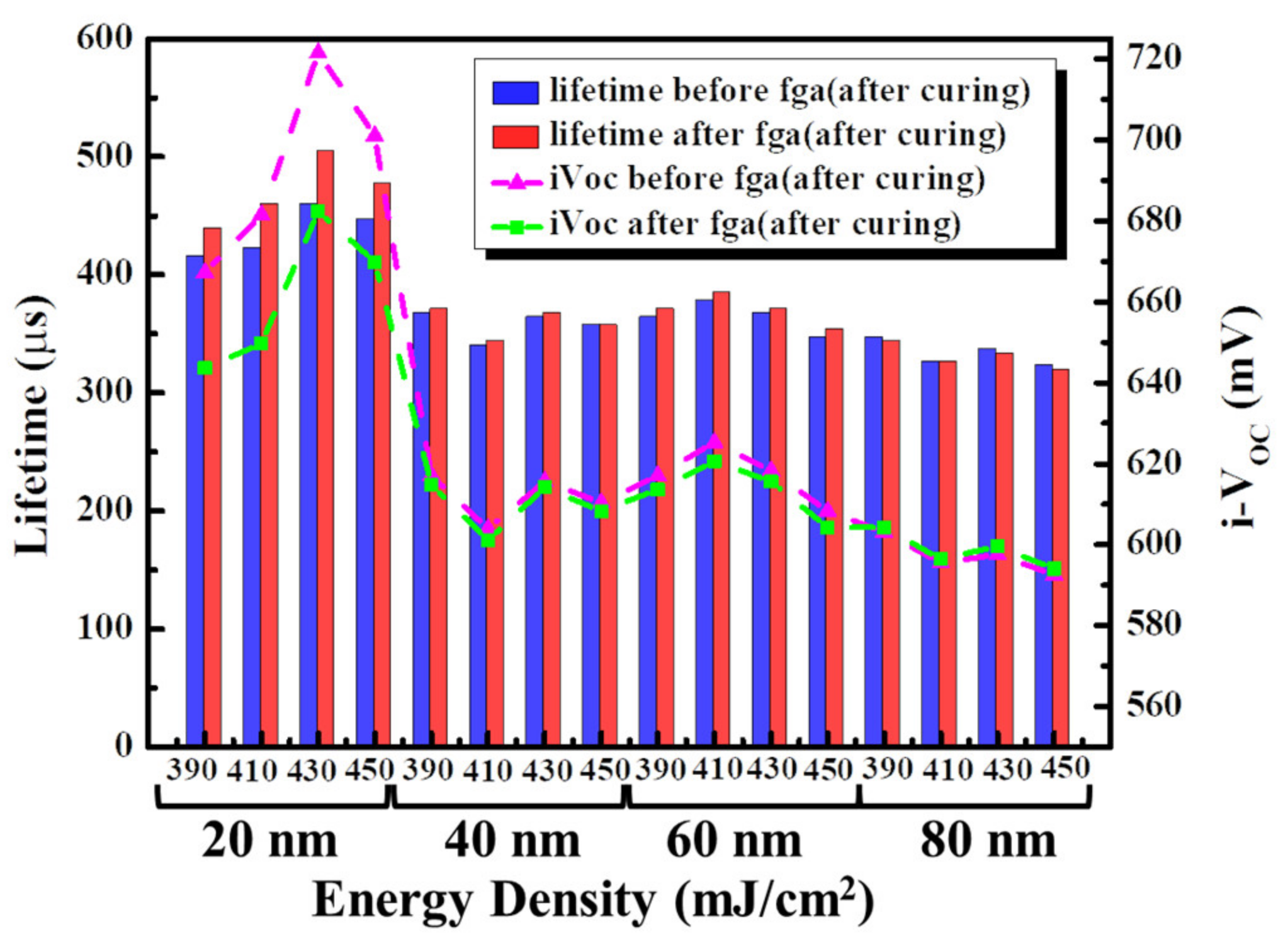

| Laser Energy Density (mJ/cm2) | 660 | 990 | 1320 | 1650 | 1980 |
| Crystalline Size (D, nm) | 86 | 140 | 75 | 78 | 66 |
| Crystallinity (Xc, %) | 64 | 97.9 | 58.1 | 55.6 | 34.4 |
© 2020 by the authors. Licensee MDPI, Basel, Switzerland. This article is an open access article distributed under the terms and conditions of the Creative Commons Attribution (CC BY) license (http://creativecommons.org/licenses/by/4.0/).
Share and Cite
Chowdhury, S.; Park, J.; Kim, J.; Kim, S.; Kim, Y.; Cho, E.-C.; Cho, Y.; Yi, J. Crystallization of Amorphous Silicon via Excimer Laser Annealing and Evaluation of Its Passivation Properties. Energies 2020, 13, 3335. https://doi.org/10.3390/en13133335
Chowdhury S, Park J, Kim J, Kim S, Kim Y, Cho E-C, Cho Y, Yi J. Crystallization of Amorphous Silicon via Excimer Laser Annealing and Evaluation of Its Passivation Properties. Energies. 2020; 13(13):3335. https://doi.org/10.3390/en13133335
Chicago/Turabian StyleChowdhury, Sanchari, Jinsu Park, Jaemin Kim, Sehyeon Kim, Youngkuk Kim, Eun-Chel Cho, Younghyun Cho, and Junsin Yi. 2020. "Crystallization of Amorphous Silicon via Excimer Laser Annealing and Evaluation of Its Passivation Properties" Energies 13, no. 13: 3335. https://doi.org/10.3390/en13133335
APA StyleChowdhury, S., Park, J., Kim, J., Kim, S., Kim, Y., Cho, E.-C., Cho, Y., & Yi, J. (2020). Crystallization of Amorphous Silicon via Excimer Laser Annealing and Evaluation of Its Passivation Properties. Energies, 13(13), 3335. https://doi.org/10.3390/en13133335





